| |
24.10.2007 Arts and politics - Two lives / INTERVIEW with Byron Morejón-Almeida, ambassador of Ecuador, and his wife Maria Corral Vega
|
cca: Thank you very much for your invitation. For starters, could you tell us something about your biography?
Byron Morejón-Almeida: Actually, I started painting when I was a child and art is still highly important in my life. Studying the history of art has been my passion. Besides the studies of the theoretical aspects of painting, I have worked with artists in my country and different other countries, where I have even been a personal friend of international masters of art. In the course of the years and with my dedication to it I even created my own artistic language. For my professional life I followed a diplomatic career, I studied Law and International Relations. I worked in places all over the world, South America, Japan and China, but mostly in Europe. We’ve been in Vienna now for almost four and a half years.
Maria Corral: In my case, I had an artistic education; I studied Interior Design, Decoration and Art.
|
|
|
|
|
|
 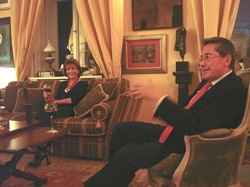
|
|
|
Maria Corral and Byron Morejón-Almeida in their studio and during the conversation
|
|
|
|
|
|
cca: Does your artistic work influence your work as Ambassador and Diplomat, and in which ways?
Morejón-Almeida: Yes, I think so. In fact, I love my work as a Diplomat, but art and painting, as I said, are my real passion. I just need this combination of these „two lives“. It also makes me much more aware of things, and the contact with other realities and sociocultural visions of the world which other societies have, and that I have appreciated during my diplomatic work, have definitely influenced my work as a painter.
|
|
|
|
|
|
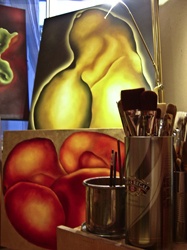 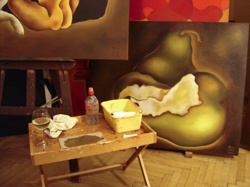 
|
|
|
Impressions of the paintings and the studio
|
|
|
|
|
|
cca: It’s interesting that you started working together artistically. Please tell us something about it. When did you start?
Morejón-Almeida: Well, we have been married for about six years and already quite in the beginning, I think about five years ago, we started painting together: one day – when I hadn’t painted in almost two years because of my busy job – I came home from work and saw a half-finished painting of María. Normally you shouldn’t do such a thing, but I simply couldn’t resist and I finished it in the most spontaneous way, adding my own style to the painting. When María told me that she really liked the result, I suggested we should continue the experiment of working together on the same painting.
Corral: Yes, and this is when we started our series together. It was all spontaneous in the beginning, it just happened very naturally. And you can really see our evolution in the paintings; we don’t need to talk about it much while working.
cca: Which is really astonishing, because you are still two individual painters with two different styles. Isn’t that difficult sometimes?
Morejòn-Almeida: Well, art is a very private and intimate experience, very individualistic. But working together is not difficult in our case. We’ve done almost 50 paintings together now; and we have accomplished to invent a conjoint technique which has given satisfactory results regarding to what we would like to express.
|
|
| |
|
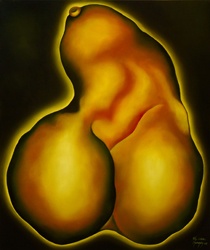  |
|
| "Plenitud" - "La persistencia de la pera" (© Morejón-Almeida/Corral) |
|
| |
|
|
cca: Why did you choose the title of the series to be „La realidad como pretexto“ (dt. „Die Realität als Vorwand“)?
Corral: It is just the perfect combination of our styles and of how we work. The style of my own works is rather naturalistic. I painted a lot of fruit, “still lifes“, for example.
Morejón-Almeida: Whereas my work is very conceptual, for example I criticize the world of consumption in my painting “El imperio de lo efimero“ (The empire of the ephemere), or in other large size paintings, where I imagine how ancient paintings could have been, if they had been painted by a contemporary painter trying to reflect perceptions or situations of today’s life, as if they were ideas projected onto the walls of Plato’s Cave.
Corral: And in our common work we mix these things together. We don’t paint normal fruit, we paint „conceptual fruit“ with a deeper meaning.
Morejón-Almeida: We want the observer to go deeper into the painting, to look further, to look behind the surface. We are trying to move the observer. It’s no „nature morte“, we believe that the fruits are alive.
Corral: That’s also why we use very conceptual titles for our paintings, for example, this big aubergine is called „Solitude“, because it is so proud of itself that it casts a golden shadow. Or we have the „Emptiness of the pear“ vs. „Fullness of the pear“, It’s like a human being: as if you were empty of thoughts, empty of sensuality - or just the opposite.
|
|
|
|
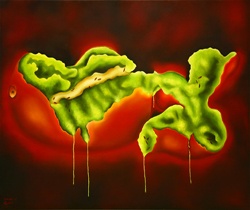 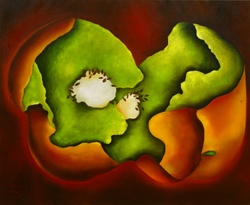 |
|
| "Me han desgarrado" - "Kiwi" (© Morejón-Almeida/Corral) |
|
| |
|
|
cca: Are the subjects of any special importance? Is there a connection to Ecuador?
Corral: Yes, in some aspect, the subject has to do something with Ecuador. We paint typical fruit from Ecuador, for example. Actually we mostly work with fresh fruits, we open them and we see something special in them what we would like to capture in a painting.
More obvious is the use of the colours, I think. As the equator traverses Ecuador, the sun is shining in a different way there than in Austria. The colours thus are much brighter, warmer and stronger in Ecuador than here. And in our paintings we also don’t use pastel, we use strong colours.
|
|
| |
|
|
cca: Do you see yourself as a promoter of Ecuadorian art and culture through your paintings or is it just a form of individual expression?
Morejón-Almeida: Yes, of course. In my job as an ambassador my duty is to promote my country, which I love doing. But through the paintings I express meanings to contact people in a more direct way, which is one of the characteristics of art as communication.
It is not our aim to make publicity for Ecuador through our paintings. But of course, in some way the observer can feel Ecuador through its colours and the glow of its equatorial light. The series that we have developed now is inspired by the colours and the forms of the magnificent fruits produced in Ecuador, as María just said.
|
|
| |
|
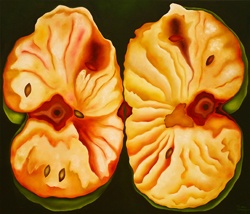 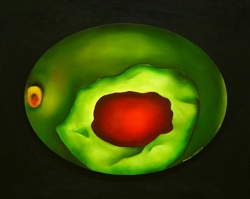 |
|
| "Reflejos" - "Aguacate (óvalo)" (© Morejón-Almeida/Corral) |
|
| |
|
|
cca: Do you have any special connection to Austria and the Austrian culture? Do you also get inspiration from the different countries you live in for your artistic work?
Morejón-Almeida: We feel really comfortable here and it’s also very important for us to get in touch with the art scene here, for example we visit Austrian museums and exhibition every weekend, and I’ve done this in all the other countries, too. Actually all the paintings of our fruit-series were painted in Austria. This is a very important connection and memory for us.
Corral: A few years ago we were invited to create the stage sets for an opera of Mozart “The Abduction from the Seraglio“. That was one of our biggest projects; we’ve done some large paintings for that.
Morejón-Almeida: Last year we also took part in an exihibition about Ecuadorian art in the Feuerwehrmuseum St. Florian in Styria. And just a few weeks ago our last exhibition in the Instituto Cervantes finished (which is entitled “Flesh Fruits” and shows the fruits series, editorial note). Now we’re starting a new series about our life in Vienna.
|
|
| |
|
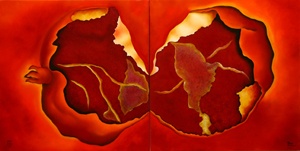 |
|
| "Los Velos de la Intimidad (diptico)" (© Morejón-Almeida/Corral) |
|
| |
|
|
cca: Please tell us something about the recent exhibition in the Instituto Cervantes and the reaction of the Austrian visitors to it.
Corral: The director of the Instituto Cervantes visited us and saw our work and he invited us to have this exhibition.
Morejón-Almeida: Actually he told us that he had already chosen the paintings he wanted to show there and that he already thought about the program. So this was kind of a surprise but we were very pleased about it. We showed about 25 paintings, some of them in a really big format, of our series “Reality as a Pretext”.
The reaction of the Austrian visitors was really good, there was a lot of interest in our work and actually quite many of our paintings now have found a new home in Austria. I think the Austrians are really interested in Ecuadorian culture and the country in general. People here are very open and sensible concerning culture in general.
cca: Thank you very much for your time and the interview.
|
|
| |
|
| |
|
| |
|
| |
|
Interview: Michaela Schüller (mis) und Rudolf Werneth (ruw)
Fotos, wenn nicht anders angegeben: Rudolf Werneth (ruw) |
|
| |
|
| |
|
|
Contact:
Byron Morejón-Almeida and Maria Corral Vega
ARGENTINIERSTRASSE 33
1040 WIEN
tel. Maria: +43 699 12244635
tel. Byron: +43 69912243293
DOWNLOAD PDF (with information about the lives and works of Maria Corral and Byron Morejón-Almeida)
|
|
 |
|
|
Zur Übersicht
|
|
|
|
Editor's Choice
Public Understanding of Science and Humanities
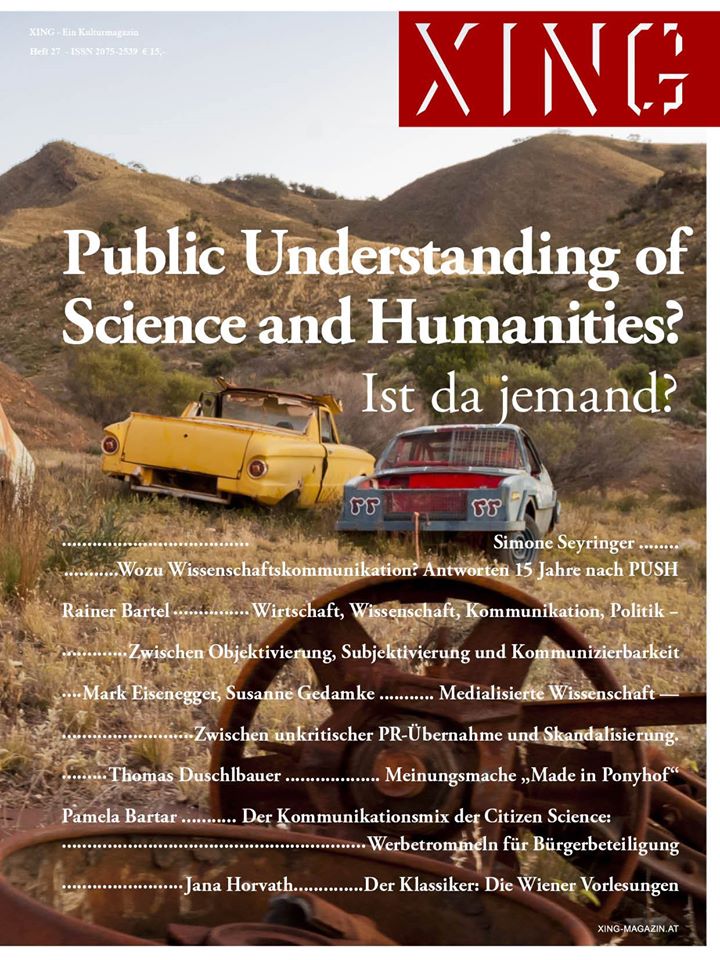 |
Reflexionen zu Public Diplomacy & Kulturdiplomatie:In der Ausgabe 27 des XING Magazins "Public Understanding of Science and Humanities" bÜberlegten zahlreiche AutorInnen, darunter Pamela Bartar (ConnectingCulture), zum Thema Wissenschaftskommunikation & PR in heimischen und internationalen Projekten.
Zur Bestellung...
|
|
Special Project Partner
EUNIC Austria

Österreich zählt zu den Gründungsländern der EUNIC, der Vereinigung der Kulturinstitute der Mitgliedsstaaten der Europäischen Union. ConnectingCulture & KulturDiplomatMagazin unterstützt als medialer Partner der EUNIC Austria ausgewählte Projekte: ConnectingCulture lädt ab 8. Oktober bis Jahresende 2015 zum Theaterfestival „Magie der Sprache“ ins Italienische Kulturinstitut in Wien.
Zum Programm...
|
Streif.Züge
European Capital of Culture 2015 - ein Reise wert
Erfahren Sie mehr über die Europäische Kulturhauptstadt
Mons in Belgien...
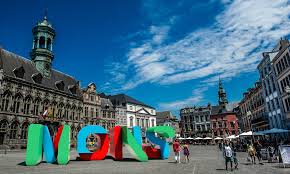
|
ARCHIV
KulturDiplomatMagazin
|
|
|